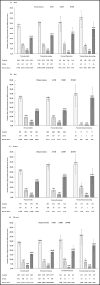Trajectories of body mass index and risk of incident hypertension among a normal body mass index population: A prospective cohort study
- PMID: 33743180
- PMCID: PMC8678668
- DOI: 10.1111/jch.14241
Trajectories of body mass index and risk of incident hypertension among a normal body mass index population: A prospective cohort study
Abstract
It is unclear whether there are different body mass index (BMI) trajectories among a population with normal BMI levels, and the association between BMI patterns and incident hypertension is not well characterized. This prospective cohort study includes surveys conducted at baseline and three follow-ups. 3939 participants who are free of hypertension at baseline or first two follow-ups were enrolled. At baseline, the age of participants ranged from 35 to 82 years and the mean age was 45.9 years. The BMI trajectories were identified using latent mixture modeling with data from the baseline and first two follow-ups. The effects of different BMI trajectories on the development of hypertension were analyzed using a Cox proportional hazard model. Four distinct BMI trajectories were identified over the study period (2004-2010): normal-stable (n = 1456), normal-increasing (n = 2159), normal-fluctuated (n = 166), and normal-sharp-increasing (n = 158). Relative to the normal-stable BMI group, the hazard ratios (HRs) and 95% confidence intervals (CIs) after adjustment for confounding factors of the normal-increasing, normal-fluctuated, and normal-sharp-increasing groups were 1.244 (1.103-1.402), 1.331 (1.008-1.756), and 1.641 (1.257-2.142), respectively. Additionally, subgroup analysis showed that the normal-fluctuated BMI trajectory was associated with a significantly higher risk of hypertension only in women (HR = 1.362; 95% CI = 1.151-1.611). The BMI trajectories were significant predictors of hypertension incidence, and increasing BMI trajectories within the currently designated normal range were associated with an increased hypertension risk, especially in women.
Keywords: body mass index; epidemiology; hypertension; prospective cohort study; trajectory.
© 2021 The Authors. The Journal of Clinical Hypertension published by Wiley Periodicals LLC.
Conflict of interest statement
The authors declare no conflicts of interest.
Figures



Similar articles
-
Association of body mass index trajectory and hypertension risk: A systematic review of cohort studies and network meta-analysis of 89,094 participants.Front Cardiovasc Med. 2023 Jan 4;9:941341. doi: 10.3389/fcvm.2022.941341. eCollection 2022. Front Cardiovasc Med. 2023. PMID: 36684600 Free PMC article.
-
Body Mass Index Trajectories During Young Adulthood and Incident Hypertension: A Longitudinal Cohort in Chinese Population.J Am Heart Assoc. 2019 Apr 16;8(8):e011937. doi: 10.1161/JAHA.119.011937. J Am Heart Assoc. 2019. PMID: 30966866 Free PMC article.
-
Trajectories of mid-life to elderly adulthood BMI and incident hypertension: the China Health and Nutrition Survey.BMJ Open. 2021 Jul 7;11(7):e047920. doi: 10.1136/bmjopen-2020-047920. BMJ Open. 2021. PMID: 34233991 Free PMC article.
-
[Trajectories of body mass index and risk of hypertension and blood pressure among Chinese adults].Wei Sheng Yan Jiu. 2023 May;52(3):354-361. doi: 10.19813/j.cnki.weishengyanjiu.2023.03.002. Wei Sheng Yan Jiu. 2023. PMID: 37500512 Chinese.
-
Effect of body mass index trajectory on hypertension among children and adolescents aged 5-18 years: a retrospective cohort study.Ann Med. 2023;55(2):2267572. doi: 10.1080/07853890.2023.2267572. Epub 2023 Oct 16. Ann Med. 2023. PMID: 37844207 Free PMC article.
Cited by
-
Associations of trajectories in body roundness index with incident cardiovascular disease: a prospective cohort study in rural China.Front Nutr. 2024 Feb 21;11:1291093. doi: 10.3389/fnut.2024.1291093. eCollection 2024. Front Nutr. 2024. PMID: 38450226 Free PMC article.
-
Sex differences in the relationship between body mass index in Chinese adolescents and future risk of hypertension: a decade-long cohort study.BMC Pediatr. 2025 Mar 12;25(1):187. doi: 10.1186/s12887-025-05555-2. BMC Pediatr. 2025. PMID: 40069609 Free PMC article.
-
Association of body mass index trajectory and hypertension risk: A systematic review of cohort studies and network meta-analysis of 89,094 participants.Front Cardiovasc Med. 2023 Jan 4;9:941341. doi: 10.3389/fcvm.2022.941341. eCollection 2022. Front Cardiovasc Med. 2023. PMID: 36684600 Free PMC article.
References
-
- Lu Jiapeng LU, Yuan WX. Prevalence, awareness, treatment, and control of hypertension in China: data from 1.7 million adults in a population‐based screening study (China PEACE Million Persons Project). Lancet. 2017;390:2549‐2558. - PubMed
-
- Kotsis V, Nilsson P, Grassi G, et al. New developments in the pathogenesis of obesity‐induced hypertension. J Hypertens. 2015;33:1499‐1508. - PubMed
-
- Ryu S, Frith E, Pedisic Z, Kang M, Loprinzi PD. Secular trends in the association between obesity and hypertension among adults in the United States, 1999–2014. Eur J Intern Med. 2019;62:37‐42. - PubMed
-
- Lissner L, Odell PM, D'Agostino RB, et al. Variability of body weight and health outcomes in the Framingham population. N Engl J Med. 1991;324:1839‐1844. - PubMed
Publication types
MeSH terms
LinkOut - more resources
Full Text Sources
Other Literature Sources
Medical

